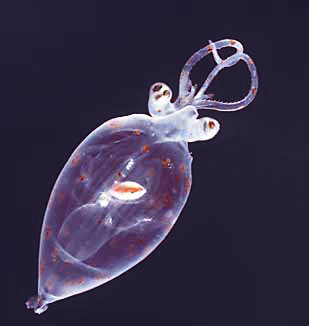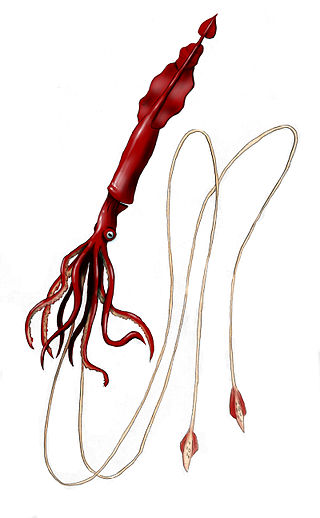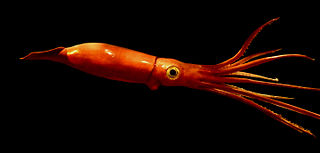
Loliginidae, commonly known as pencil squids, is an aquatic family of squid classified in the order Myopsida.

The Mastigoteuthidae, also known as whip-lash squid, are a family of small deep-sea squid. Approximately 20 known species in six genera are represented, with members found in both the mesopelagic and bathypelagic zone of most oceans. Originally described by Verill in 1881, it was later lowered by Chun (1920) to a subfamily (Mastigoteuthinae) of the Chiroteuthidae. However, Roper et al. (1969) raised it back to the family level, and this has not been changed since. The taxonomy of this family is extremely unstable, and there have been at times one genus, two genera and four subgenera(Salcedo-Vargas & Okutani, 1994), two genera and several 'groups', five genera and one species with an uncertain placement, or six genera.

The hooked squid, family Onychoteuthidae, currently comprise about 20–25 species, in six or seven genera. They range in mature mantle length from 7 cm (2.8 in) to a suggested length of 2 m for the largest member, Onykia robusta. The family is characterised by the presence of hooks only on the tentacular clubs, a simple, straight, funnel–mantle locking apparatus, and a 'step' inside the jaw angle of the lower beak. With the exception of the Arctic Ocean, the family is found worldwide.

Bigfin squids are a group of rarely seen cephalopods with a distinctive morphology. They are placed in the genus Magnapinna and family Magnapinnidae. Although the family was described only from larval, paralarval, and juvenile specimens, numerous video observations of much larger squid with similar morphology are assumed to be adult specimens of the same family.

Decapodiformes is a superorder of Cephalopoda comprising all cephalopod species with ten limbs, specifically eight short arms and two long tentacles. It is hypothesized that the ancestral coleoid had five identical pairs of limbs, and that one branch of descendants evolved a modified arm pair IV to become the Decapodiformes, while another branch of descendants evolved and then eventually lost its arm pair II, becoming the Octopodiformes.

Loligo is a genus of squid and one of the most representative and widely distributed groups of myopsid squid.

The European squid or common squid is a large squid belonging to the family Loliginidae. It occurs abundantly in coastal waters from the North Sea to at least the west coast of Africa. This species lives from sea level to depths of 500 m (1,600 ft). Its mantle is up to 40 cm (16 in) long. The species is extensively exploited by commercial fisheries.

Taningia danae, the Dana octopus squid, is a species of squid in the family Octopoteuthidae. It is one of the largest known squid species, reaching a mantle length of 1.7 m (5.6 ft) and total length of 2.3 m (7.5 ft). The largest known specimen, a mature female, weighed 161.4 kg (356 lb).[nb a]

Magnoteuthis is a genus of whip-lash squid containing at least three species. Some teuthologists consider Idioteuthis or Mastigoteuthis synonymous with this taxon, but it is genetically and morphologically distinct.

Asperoteuthis is a genus of chiroteuthid squid comprising four species:
Notonykia nesisi is a species of squid in the family Onychoteuthidae. It is differentiated from Notonykia africanae by the shape of the tentacles. While the species is only known from immature specimens, it is known to achieve a mantle length of at least 100 mm. The tentacles are about 65-115% of the mantle length, and contain 6-18 hooks.
Asperoteuthis nesisi is a chiroteuthid squid of the genus Asperoteuthis. It is native to the waters off South Georgia and, more generally, the Southwest Atlantic. Asperoteuthis nesisi has a thin mantle and arms, and peculiar integumental tubercles on its head and mantle. The largest arm suckers possess twelve to fourteen sharp, triangular teeth.

Sepioteuthis, commonly known as reef squids or oval squids, is a genus of pencil squid. Reef squids are easily recognizable by their large rounded fins that extend along almost the entire length of their mantles, giving them a superficial resemblance to cuttlefish.

Illex coindetii, commonly known as the southern shortfin squid or broadtail shortfin squid, is a species of neritic squids in the family Ommastrephidae. They are found in the Mediterranean Sea and on both sides of the north Atlantic Ocean.

Cephalopod fins, sometimes known as wings, are paired flap-like locomotory appendages. They are found in ten-limbed cephalopods as well as in the eight-limbed cirrate octopuses and vampire squid. Many extinct cephalopod groups also possessed fins. Nautiluses and the more familiar incirrate octopuses lack swimming fins. An extreme development of the cephalopod fin is seen in the bigfin squid of the family Magnapinnidae.

Cephalopods exhibit various dermal structures on their mantles and other parts. These may take the form of conspicuous warts, cushions, papillae or scales, though in many species they are microscopic tubercles. The most elaborate forms are found among the oceanic squid of the order Teuthida.
Richard E. Young is a teuthologist. He is an Emeritus Professor of Oceanography at the University of Hawaii's School of Ocean and Earth Science and Technology.

Narrowteuthis is a monotypic genus of squid, the sole member is Narrowteuthis nesisi, from the family Neoteuthidae. It is known from just two specimens caught off the Canary Islands at 27°18'N, 19°44'W.
Nototeuthis is a monotypic genus of squid, in the family Neoteuthidae. The only species in this genus is Nototeuthis dimegacotyle . This species is characterised by short tentacular clubs, less than 40% of the length of the mantle, and relatively long fins, which are approximately 60% of the mantle length. The tentacle clubs have two greatly enlarged suckers on distal portion of the manus, which distinguish N. dimegacotyle from other members of the Neoteuthidae. Few specimens of this species are currently known. Specimens have been collected from the south eastern Pacific Ocean, off Chile, between the Southern Subtropical and the Antarctic Polar frontal zones. This species is mesopelagic to bathypelagic and can be found from near the surface to a depth of ~500m.

Architeuthoidea is a superfamily of squid in the order Oegopsida.















